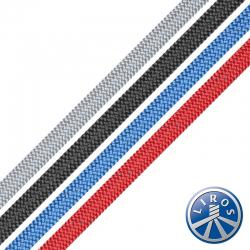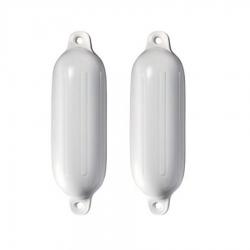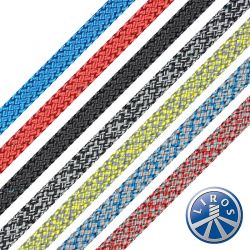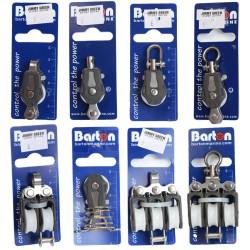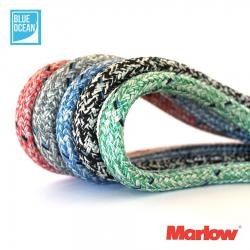Anchor Chain Snubbing Guide
Anchor Chain Snubbing is fundamental to the basic principles of anchoring on all-chain anchor rode. The Snubber protects your windlass by transferring the strain to a suitable deck strongpoint and provides the vital stretch required to alleviate the shock loads associated with a bar-taut chain.
There are multiple options for snubbing solutions, including stainless steel chain hooks, grippers, and grabs with or without a nylon tail or twin tails (V-Bridle).
Select Three-Strand or Anchorplait for single strops or Anchorplait for V-bridles.
Single-line strops can be used over the bow roller or, as a temporary solution, offset via the forward mooring fairlead.
Twin strop lines (V-shaped bridles) are ideal for leading through handed deck fairleads to the forward mooring cleats.
The chain should be secured to a mooring cleat, Samson Post, or routed through a Chain Stopper for added security in case the snubbing line or bridle fails.
The windlass should only be the strong point of last resort.
Tips on Deployment of a Chain Snubbing Line:
- Pay out the desired length of chain
- Secure the end of the snubbing line or bridle on deck
- Attach the hook/gripper/grab to the chain
- Ease out the chain until the rope is taking the strain - this will entail ensuring that the snubber remains attached
- Ease the chain out again to create a slack loop
- Remember to allow for the rope to stretch
Selecting the Snubbing Rope Fibre:
LIROS Nylon is the stretchiest suitable fibre, which will elongate approximately 20% at the breaking point. Polyester will stretch approximately 15% at rupture, which is slightly less but still enough to provide shock absorption.
There is no material difference in elasticity between Three-Strand and Anchorplait/Octoplait Eight-Strand Construction.
Remember that the aim is for the rope to take the strain.
Selecting the Snubbing Line Diameter:
Select a line diameter that is comparable in breaking load to your anchor chain (or your theoretical bower anchor warp)
Remember that an oversized nylon line will not stretch as much as the correct specified diameter.
A slightly undersized nylon line will provide more shock absorption but may ultimately prove sacrificial.
These are the key factors for specifying the correct snubbing line diameter:
- the type of anchoring
- the likely weather conditions
- the exposure of the anchorage
- the length of time at anchor
- whether the yacht is unattended
- the worst-case scenario
Selecting your Chain Snubbing attachment: Hook, Grab or Gripper (Shackle)
Chain Hooks and Grabs are designed to achieve a simple but strong means of securing a line to a length of chain under load.
The internal dimensions of each link in a modern calibrated anchor chain are not large enough to facilitate a strong internal connection.
Chain hooks and grabs are designed to fit over a link in one plane and rest on the following link, which will naturally be at right angles to it.
Therefore, the link on which the hook or grab rests takes the load.
Chain Hooks, Grippers and Grabs can be divided into two broad categories:
- Retentive - featuring a mechanism that keeps the line attached when it is slack
- Plain - no retention mechanism, but more straightforward and less fiddly to attach and detach
There are other options for securing the snubbing line to the chain:
- Fasten the line to the chain with a rolling hitch. An extra half hitch or two is advisable for additional security. A rolling hitch should present no problems regarding release, even after extended exposure to heavy loads, providing it is tied correctly.
N.B knots have a detrimental effect on rope strength: Strength loss through tying knots - Make up a suitably strong, spliced endless loop, i.e. a Prusik Cord from, e.g. 100% Dyneema SK75, 78 or 99 braided line and connect it to the chain using a Prusik Hitch
Bear in mind that attaching the snubbing line to the chain by whatever means you select may require stooping, kneeling, and leaning out over the bow roller. And that applies to detaching it as well.
Attaching the hook or grab with a shackle may seem a little clunky, but it does mean that the hook can be removed, allowing the line to be used as a mooring warp and then re-shackled as required.
Tips on Choosing between a Single Strop and a Twin Tail V Bridle Chain Snubber
Single-Line Chain Snubbing Strop
Single snubbing lines address the issue of snatch loading associated with all chain anchor rode systems, consisting of a single stretchy nylon line that takes the strain to moderate any sudden surges in the load.
The snubbing line can be led offset through a port or starboard fairlead, but for longer-term anchoring, it should pass over the bow roller, through the stemhead fitting, and attach to the most suitably positioned central strongpoint.
This will require a careful, precautionary appraisal of any potential wear points and preventive action where necessary, e.g. Anti-Chafe Tubular Webbing or PVC hose.
Single Line Chain Snubbing: Facts and Features
- A snubbing line can be approximately 3 metres to 10 metres in length - the longer it is, the more it will stretch, but the more unmanageable it may become.
- The strop is attached to the chain with a rolling hitch or a spliced chain hook/grab, which can be retentive. The other end should be made fast to a strong point on the foredeck.
- The strength of the rope should be comparable to the breaking load of your main anchor chain.
- Splicing provides the optimum security because it retains far more of the rope strength than tying a knot - knots can reduce the break load by as much as 50%, while a professional splice will generally retain approximately 80-85% of the original load capacity - both these percentages may vary according to the rope fibre, rope construction, type of knot and the splice construction.
- Adding a mooring compensator will increase the elasticity of the strop; this extra shock-absorbing capacity could be utilised to reduce the length of the line.
- Adding anti-chafe webbing will protect the line where it leads over the bow roller, through the stem fitting and where it may come into any abrasive contact from there to the strongpoint.
V-Shaped Bridles for Anchor Chain Snubbing
Twin-tail snubbing bridles offer an excellent shock-absorbing solution when the forward deck layout or stem head and bow roller design and dimensions are not conducive to the successful arrangement of a single snubbing line.
Jimmy Green V-Shaped Twin Tail Snubbing: Facts and Features
- A Jimmy Green V-shaped bridle is based on the Anchorplait centre eye splice, with or without a thimble for attaching a chain hook.
- The bridle consists of a continuous line, formed into a soft loop around the eye of a fitting or a hard thimble eye with a Brummel locking tuck splice.
- The strength of the bridle is therefore not reliant on splicing two separate ropes together, i.e. a Y Joining Splice
- The maximum deployment angle must always be set up with caution, but the centre eye splice is much less prone to failure at a wider than optimum angle than any joining splice between two separate ropes.
- It is impossible to successfully put a centre eye splice in a rope of three-strand construction. However, it is possible to use two separate lines, providing the attachment eye has sufficient capacity.
- The strength of the rope should be comparable with the breaking load of your main anchor chain.
- Splicing retains far more of the rope's strength than tying a knot; knots can reduce the break load by as much as 50%, whereas a professional splice will generally retain approximately 80-85% of the original load capacity, a percentage that varies depending on the rope and splice construction.
- Each tail (leg) of a Jimmy Green snubbing bridle should be approximately 3 metres to 10 metres in length. The longer it is, the more it will stretch, but the more unmanageable it may become.
- The maximum deployment angle must always be set up with caution, but the centre eye splice is much less prone to failure at a wide angle than any joining splice between two separate ropes.
- Adding a mooring compensator will increase the elasticity of the strop; this extra shock-absorbing capacity could be utilised to reduce the length of the line.
- Adding anti-chafe webbing will protect the lines as they lead through the forward fairleads and onto the mooring deck cleats.
Anchorplait Nylon (Octoplait Eight-Strand Construction) is the only rope option to consider for making a V-Bridle
LIROS Three-Strand and Anchorplait Nylon, Rope Construction and Properties Comparison:
LIROS 3-Strand Nylon Article 00110
- Thermofixed twisted lay construction 100% high tenacity Nylon (Polyamide)
- Manufactured to DIN EN ISO 1140 (previously DIN EN 696, DIN 83330)
- Spliceable to chain
- Dependable strength
- Excellent durability
- UV and abrasion resistant
- Excellent shock absorbing elasticity >20% working load stretch
- LIROS Break Load: 10mm 2400kg ~ 12mm 3300kg ~ 14mm 4400kg ~ 16mm 5600kg ~ 18mm 7000kg ~ 20mm 8140kg ~ 24mm 11800kg ~ 30mm 17400kg
LIROS 3-Strand Nylon has the same strength and stretch properties as the octoplait version, but it is less expensive. However, the twisted lay shrinks when drying after immersion in water, causing it to become stiff, especially in larger diameters.
Overall, a powerful and stretchy mooring warp that represents excellent value when used for semi-permanent mooring but is not usually recommended for frequently adjusted and stowed mooring warps due to the stiffening of the line over its lifetime.
Anchorplait® is a UK-registered Trademark
LIROS Anchorplait® White Nylon Article 01058JG is manufactured EXCLUSIVELY by LIROS Ropes with Easy Splice Markers for Jimmy Green Marine.
The eight-strand construction, featuring two pairs of left-hand and two pairs of right-hand strands, delivers a balanced performance with no undesirable twist under tension.
Anchorplait is the rope that won't cockle.
In fact, it falls and flakes like a chain.
Anchorplait makes an ideal snubbing line because it remains supple throughout its working life.
LIROS Anchorplait White Nylon Article 01058JG Facts, Features and Plus Factors:
- Jimmy Green Exclusive
- 100% Nylon (Polyamide)
- UV stabilised
- Square braid construction
- Non-kinking
- Balanced braiding
- The eight-strand construction - two pairs left hand, two pairs right hand - ensures a balanced performance and no twist under tension
- Dependable strength
- Excellent durability
- UV and abrasion resistant
- Zero possibility of cockling
- Falls and flakes like a chain
- Excellent weathering and wear resistance properties
- Superb handling, manageable in long lengths
- Excellent Shock Absorbing Elongation, >20% working load stretch
- Remains supple for the duration of its working life
- Splice-able to chain - very strong 1-link splice to chain or flexible 11-link splice to chain
- Available from 10mm up to 20mm diameter
LIROS specify their manufacturer minimum break loads in Deka newtons = DaN
1 Deka newton DaN = 1.01971621297793kg (approximately 1.02kg)
| 10mm | 12mm | 14mm | 16mm | 18mm | 20mm | 24mm |
|---|---|---|---|---|---|---|
| 2400daN | 3300daN | 4400daN | 5600daN | 7000daN | 8140 daN | 11800daN |
| 2652kg | 3468kg | 4590kg | 6018kg | 7344kg | 8364kg | 12036kg |
LIROS Break Load converted to Kg from DaN at 1:1.02
Read our article Anchor Snubbing - A Guide to taking the shock Load off your Windlass and Chain








